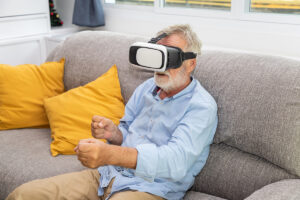 Virtual Reality (VR) devices are hugely popular now—providing a 360-degree immersive experience. The platform offers the opportunity to take part in activities that are otherwise not available to us due to distance, expense, or other factors. Whether the activity is travel, exercise, or something as simple as sitting in a room with 50 puppies, VR provides an opportunity to broaden our world.
Virtual Reality (VR) devices are hugely popular now—providing a 360-degree immersive experience. The platform offers the opportunity to take part in activities that are otherwise not available to us due to distance, expense, or other factors. Whether the activity is travel, exercise, or something as simple as sitting in a room with 50 puppies, VR provides an opportunity to broaden our world.
When most of us think of someone using a VR headset, it’s pretty common to imagine the user as a young, technically savvy person. Did you know that VR technology is being used by older people? Senior Centers, Assisted Living and Nursing facilities, and other senior service providers are now offering VR experiences to people over the age of 60.
As we age, it is not uncommon for our social circle to become smaller. The reasons for this can include limited mobility, difficulties with transportation, the loss of friends and family, financial concerns, and more. Loneliness and social isolation have become a major health issue for older Americans as both conditions can lead to a myriad of health concerns such as cognitive decline, depression, and heart disease.
VR is now being used for a variety of services to help people.
One very simple way that VR is being utilized is to help orient people to their new home before they relocate to an Assisted Living or Nursing facility. Although relocation is often needed to ensure the continued well-being of an elder, the stress of relocation can be detrimental. Some facilities are now offering a VR experience to help ease the transition from one home to the next.
Another way that VR is being used is to offer users the opportunity to visit an almost unlimited number of places. A user might want to walk down a street in the town where they grew up. When used in a group, the user can point out their childhood home, their school, or their favorite restaurant to the other group participants. Users can also visit museums, national parks, or other amazing venues throughout the world. If a user always wanted to visit The Louvre in Paris or Tokyo’s Shibuya Crossing, it’s now possible through VR.
During the pandemic shutdown, VR was utilized to help older family members participate in family gatherings, while maintaining their need for social distancing. Holiday celebrations, milestone events such as weddings, and more were shared with older family members through VR technology. Assisted living and nursing facilities were able to utilize VR systems in individual rooms, but link the experience so that the residents were able to “socialize” at a distance.
VR is also being used to help Caregivers understand what it feels like to live with dementia. VR has been found to be a very useful staff training tool.
TexasMonthly.com offered an article “Can Virtual Reality Make Older Adults Happier and Healthier?” in March 2022 (https://www.texasmonthly.com/news-politics/virtual-reality-in-eldercare/). In the article, Aaron Tate, Director of Emerging Technology at the University of Texas at Dallas’s Center for BrainHealth is quoted “Any activity that promotes curiosity, critical thinking, and meaningful social engagement is good for the brain’s health and fitness. Virtual reality’s ability to give users a sense of presence by stimulating the visual, auditory, and vestibular systems allows them to experience new and remembered—or forgotten—experiences like never before.”
SeniorCare is developing VR programming for use in private homes, senior centers, assisted living facilities and more. For more information on this innovative programming, please contact SeniorCare at 978-281-1750.
